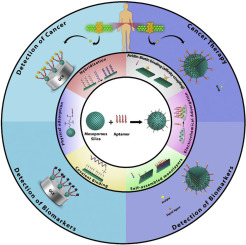Trends in Analytical Chemistry ( IF 11.8 ) Pub Date : 2019-12-23 , DOI: 10.1016/j.trac.2019.115778 Houman Kholafazad Kordasht , Mahdiyeh Pazhuhi , Paria Pashazadeh-Panahi , Mohammad Hasanzadeh , Nasrin Shadjou

|
Mesoporous silica nanoparticles (MSNs) are an essential and inseparable part of scientific application in today’s world. These materials garnered more attention, in biosensing, catalysis, bioimaging, energy storage, and disease diagnosis due to their privileged futures. The unique physiochemical properties have been made these nanomaterials an excellent candidate for drug delivery applications as well as electrochemical and optical biosensing. MSNs are able to encapsulate enormous materials in their structural pores and deliver those materials to target, more meticulously. Aptasensor is type of biosensors that use aptamer for increasing selectivity and sensitivity. These are capture by nanomaterials by covalent and non‐covalent linking for many different purpose such as diagnosis and target therapy. The aim of this review is introducing the most recent research progress on aptasensors based on MSNs, including various optical and electrochemical aptasensors, their strategy, and procedure, limit of detection, as well as their advantages and limitation. Moreover, different types of aptasensors based on MSNs is highlighted in this review for targeting and treatment of cancer cells. Although encouraging and interesting investigations have been achieved in this filed, design and mass production and effective biological application of aptasensors and MSNs based aptasensors are still challenging.
中文翻译:

基于中孔二氧化硅纳米粒子的多功能适体传感器作为生物分析应用的有效平台:最新进展
介孔二氧化硅纳米颗粒(MSN)是当今世界科学应用中必不可少的部分。这些材料因其优越的未来而在生物传感,催化,生物成像,能量存储和疾病诊断方面引起了更多关注。这些纳米材料具有独特的物理化学特性,非常适合用于药物输送应用以及电化学和光学生物传感。MSN能够将大量材料封装在其结构孔中,并将这些材料更精确地传递到目标。适体传感器是使用适体来提高选择性和灵敏度的生物传感器类型。这些被纳米材料通过共价和非共价连接捕获,用于许多不同目的,例如诊断和靶标治疗。这篇综述的目的是介绍基于MSN的适体传感器的最新研究进展,包括各种光学和电化学适体传感器,它们的策略和过程,检测极限以及它们的优缺点。此外,在这篇综述中重点介绍了基于MSN的不同类型的适体传感器,用于靶向和治疗癌细胞。尽管在此领域中已经获得了令人鼓舞和有趣的研究,但是适体传感器和基于MSNs的适体传感器的设计和批量生产以及有效的生物学应用仍然具有挑战性。在这篇综述中重点介绍了基于MSN的不同类型的适体传感器,用于靶向和治疗癌细胞。尽管在此领域中已经获得了令人鼓舞和有趣的研究,但是适体传感器和基于MSNs的适体传感器的设计和批量生产以及有效的生物学应用仍然具有挑战性。在这篇综述中重点介绍了基于MSN的不同类型的适体传感器,用于靶向和治疗癌细胞。尽管在此领域中已经获得了令人鼓舞和有趣的研究,但是适体传感器和基于MSNs的适体传感器的设计和批量生产以及有效的生物学应用仍然具有挑战性。











































 京公网安备 11010802027423号
京公网安备 11010802027423号